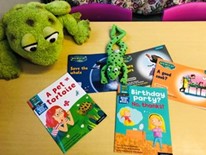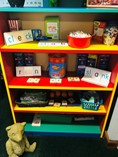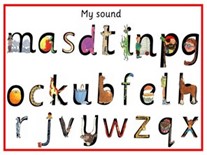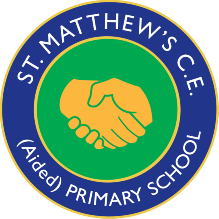Our Vision for Phonics
At St Matthew’s Primary school, our school vision is to encourage all children to flourish spiritually, morally, emotionally, physically and intellectually in all aspects of life demonstrating perseverance and resilience; this is emulated across all curriculum areas.
Phonics
Children in Early Years and Key Stage 1 are taught phonics in Read Write Inc. (Ruth Miskin Literacy) lessons. Read Write Inc. is a phonics programme that encourages children to read and write with speed and accuracy. Children are taught letter sounds (speed sounds) and how to blend letter sounds to read words. They practise their blending skills by reading and writing using their phonic books. An important part of our phonics lessons is reading and understanding the books and particularly learning new vocabulary. Children also practise applying their phonic skills to spelling and writing activities and are grouped by reading ability for these lessons. At St Matthew's we follow the phonics program of Read Write inc.



What is Read Write Inc?
Read Write Inc (RWInc) is a phonics complete literacy programme which helps all children learn to read fluently and at speed so they can focus on developing their skills in comprehension, vocabulary and spelling. The programme is designed for children aged 4-7. However, at St Matthew's we begin the programme in Nursery and will continue teaching RWInc to children beyond the age of 7 if they still need support in their reading.
How will RWInc be taught?
All children are assessed regularly by our RWInc lead teacher and then grouped according to what sounds the children know, ability to blend words to read their fluency in reading. This is so children work at the same level which help to allow complete participation in lessons.
Reading
The children –
- learn 44 sounds and the corresponding letters/letter groups using simple picture prompts.
- learn to read words using Fred talk and sound blending.
- read from a range of storybooks and non-fictions books matched to their phonic knowledge.
- work well with partners.
- develop comprehension skills in stories by answering ‘Find It’ and ‘Prove It’ discussion questions.
Writing
The children –
- learn to write and form the letters/letter groups which represent the 44 sounds with the help of fun phrases.
- learn to write words by using Fred Talk.
- learn to build sentences by practising sentences out loud before they write.
Talking
The children work in pairs so that they –
- answer every question.
- practise every activity with their partner.
- take turns in talking and reading to each other.
- develop ambitious vocabulary.
In Nursery
In Nursery, we focus on developing children’s speaking and listening skills and lay the foundations for the formal phonic work which starts in Reception. The emphasis during this time is to get children attuned to the sounds around them by playing games and learning about instrumental sounds, body percussion, rhythm and rhyme, alliteration, environmental sounds, voice sounds and oral blending and segmenting. Children will learn the picture and rhyme for the set 1 sounds within their continuous provision and then in short formal sessions within the Summer term before they start Reception.
In Reception
In Reception all children will learn how to ‘read’ the sounds in words and how those sounds can be written down.
In Year One and the start of Year Two
Children follow the same format as Reception but will work on complex sounds and read books appropriate to their reading level. Daily sessions of RWInc phonics last for 40 minutes at the beginning of the day.
Five key principles underpin the teaching in all Read Write Inc. sessions –
- Purpose – know the purpose of every activity and share it with the children, so they know the one thing they should be thinking about.
- Participation – ensure every child participates throughout the lesson. Partnership work is fundamental to learning.
- Praise – ensure children are praised for effort and learning, not ability.
- Pace – teach at an effective pace and devote every moment to teaching and learning.
- Passion – be passionate about teaching so children can be engaged emotionally.
Children will be taught how to read as follows –
Before you start to teach your child, practise saying the sounds below. These are the sounds we use to speak in English.

Fred Talk
We use pure sounds (‘m’ not’ muh’,’s’ not ‘suh’, etc.) so that your child will be able to blend the sounds into words more easily. At school we use a puppet called Fred who is an expert on sounding out words! we call it, ‘Fred Talk’. E.g. m-o-p, c-a-t, m-a-n, sh-o-p, b-l-a-ck

How parents can help.
The Oxford owl website is a brilliant resource for parents, it has practice sheets, helpful guides, resources, online books and much more. Below are some links to support you with teaching phonics at home with your child. It demonstrates how to say the sounds in a pure way and gives you some helpful tips too.
https://www.ruthmiskin.com/en/find-out-more/parents
Here are some further links to fun games that can support your children with phonics at home -
https://www.readwithphonics.com/
https://onlinephonicsgames.com/
Oxford Owl for School and Home
Statement of Intent, Implementation and Impact
Intent
Read, Write, Inc (RWInc) is a consistent, rigorous and creative phonics programme designed to teach every child how to read. Using synthetic phonics, children quickly learn to blend letter sounds together following a fun, effective and inclusive programme to enable children to flourish as readers. Furthermore, RWI is used as an additional intervention programme to secure reading skills for children not making expected progress with phonics. We want the children to experience wonder and enjoyment through reading igniting imagination and a love of books. As a school, we are determined that every pupil will learn to read, regardless of their background, needs or abilities. The school has clear expectations of pupils’ phonics progress and we ensure that the teaching of reading is of an excellent standard to create children who take pleasure in reading.
Implementation
Through the teaching of the RWI phonics programme the children are taught the essential skills needed for reading. Phonics is taught daily to all children in Foundation Stage, and KS1. Extra support is provided to those in Year 2 who have not passed phonics screening in Year 1 and interventions are planned for those children who are working below expected levels. Staff systematically teach learners the relationship between sounds and the written spelling patterns, or graphemes, which represent them. Phonics is delivered in ability groups across EYFS and KS1 to enable children to make rapid progress in their literacy skills. Pupils have regular reading sessions with an adult we ensure the pupils are regularly practising and applying their phonics knowledge. In the EYFS the continuous provision matches the pupil’s current knowledge and understanding whilst ensuring the children are suitable challenged. Reading leaders regularly assess the pupil’s phonics knowledge using RWI assessments. These regular assessments inform planning and allow teachers to identify any gaps in learning. The children have reading books which they are encouraged to read regularly at home which match their current phonics level.
Impact
At St Matthew’s, through our consistent teaching of systematic phonics, our aim is for children to become fluent readers by the end of Key Stage One. This way, children can focus on developing their fluency and comprehension as they move through the school. Attainment in reading is measured using the statutory assessments at the end of Key Stage One and Two. These results are measured against the reading attainment of children nationally. Attainment in phonics is measured by the Phonics Screening Test at the end of Year 1. However, we firmly believe that reading is the key to all learning and so the impact of our reading curriculum goes beyond the results of the statutory assessments.
St Matthews CofE Phonics Overview
Progression in Read Write Inc Phonics
Key Priorities for Phonics at St Matthews
